TAMUG Comprehensive Research Funds
TCRF 2022
Funds are provided by the Texas Legislature to increase the research capacity of the Galveston Campus. Equipment purchased by these funds are considered to be a departmental/campus resource and should be made available to other interested TAMUG users. Publications resulting from this item should acknowledge support from Texas A&M.
- Overcoming bottlenecks to finfish larviculture
- Cybersecurity in Supply Chains: Towards Cyber Resilience and Robustness
- Shifting Hazard Governance from Recovery to Protection
- Development of a citizen-science mobile application for chronic coastal flooding in Houston-Galveston
- Understanding pirate activities during the Golden Age of Piracy (roughly 1650-1720) and how it can be translated into tourism activities that strengthen local coastal economies and educate visitors
Overcoming bottlenecks to finfish larviculture
An investigation into the relationship between larval
Dr. David Hala & Dr. Lene Petersen
The proposed project will address existing barriers to southern flounder (Paralichthys lethostigma) larviculture as they relate to the low and variable survival of larval flounder during hatchery operations. The objective of this proposal is to investigate the relationship between larval growth, bioenergetics (metabolic rate), and endocrinology (hormones) in developing southern flounder larvae. The results our project will provide new knowledge on the relationship between larval southern flounder physiology (i.e., metabolic rate and hormone levels), growth, and survival. The identification of an underlying physiological cause for poor survival or growth can help to determine the implementation of mariculture strategies that may alleviate the low survival bottleneck to hatchery operations.
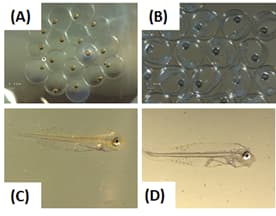
Image showing southern flounder embryos and larvae at various stages of development: unfertilized eggs (A), 48 hours post-fertilization embryos (B), 5 days post-hatch larva (C), and 10 days post-hatch larva (D).
Cybersecurity in Supply Chains:
Towards Cyber Resilience and Robustness
Dr. Amer Jazairy
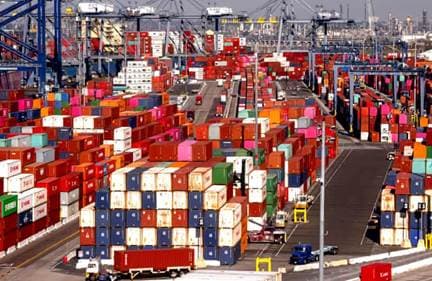
Supply chain disruption in ports in the US impacting the exchange of goods and services. Image: theguardian.com
A cyberattack on one actor in the supply chain can negatively impact it alongside the other actors connected to it (directly or indirectly) across that chain, yet knowledge is still scarce on how supply chain actors perceive and respond to the different forms of cyberattacks. This project aims to increase knowledge on cyber-related risks and mitigation strategies adopted in the supply chain as seen by manufacturing firms. TCRF funds will be used to design a web-based survey on cybersecurity in supply chains and distribute it to a wide – carefully targeted – sample of supply chain/purchasing managers employed at US manufacturing firms. Hypotheses on the relationships between different types of cyber-related risks, mitigation strategies and the supply chain’s cyber- resilience and robustness will be tested. The funds will also support generating and disseminating academic and practitioner reports, supporting TAMUG’s impact on both fronts.
Information: jazairy.a@tamug.edu
Shifting Hazard Governance from Recovery to Protection
Dr. Ashley Ross
A thriving Blue Economy relies on protection of our coastal communities from natural hazards. Protection is forward-looking, not simply a ‘return to normal’. Current natural hazard management in our country is dominated by recovery from the last disaster. This largely stems from funding mechanisms that are tied to disaster events. Where improvements are made to mitigate against hazard risk, they often are not ambitious enough to address the future impacts of climate change. Consequently, disaster costs are rising while more severe and frequent extreme storms are looming. To meet these challenges, a proactive approach is needed, one that prioritizes risk reduction as a public good. European countries such as the Netherlands have strategically pursued protection over recovery, and some localities across the nation are making and implementing climate adaptation plans to protect against future hazard impacts. The question remains, however, how this is accomplished in a policy and funding environment that incentivizes reactive, rather than proactive, disaster management. The objective of this project is to identify the factors associated with local and regional projects that promote protection to future climatic conditions.
To evaluate this, we will analyze hazard planning documents in the Gulf and Atlantic Coast regions using an innovative method only recently applied in this context – natural language processing (NLP). NLP is a machine learning technique that allows for text clustering and classification. This tool provides a method to assess a large number of plans to identify the mechanisms supporting disaster mitigation and protection across our nation’s coastal communities.
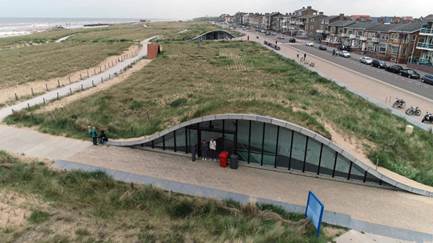
Example of hazard protection: Manmade sand dunes serve as flood protection and cover a parking garage in the town of Katwijk, Netherlands (Image Source: CBS News)
Information: ashleydross@tamug.edu
Development of a citizen-science mobile application for chronic coastal flooding in Houston-Galveston
Dr. David Retchless & Dr. William Merrell
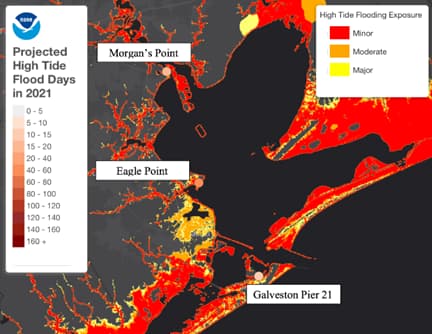
Areas flooded by minor, moderate, and major high tide flooding on Galveston Island and in surrounding communities (NOAA 2021).
TCRF support will provide seed funding for development of a “Coastal Flood Spotter” mobile application (“app”) for the Houston-Galveston metro region. Houston-Galveston is increasingly vulnerable to chronic hightide flooding (Figure 1). This vulnerability is heightened by a simultaneous increase in extreme rainfall events in the metro region. The app will be designed to address the region’s chronic flood vulnerability via two objectives: 1) Increasing hazard awareness through personalized and timely presentation of hazard information to stakeholders in hightide and compound flood hazard zones; and 2) Enhancing future flood forecasts by leveraging widespread use of mobile devices to enable “human sensors”-based citizen science for hightide and compound flooding.
Information: retchled@tamug.edu
Understanding pirate activities during the Golden Age of Piracy (roughly 1650-1720) and how it can be translated into tourism activities that strengthen local coastal economies and educate visitors
Dr. Elizabeth Nyman & Dr. Jenna Lamphere
We aim to expand the definition of marine resources beyond tangible items like fish and offshore energy by understanding how intangible marine resources like cultural heritage act as part of the Blue Economy. As such, we are proposing a case study of an area known for both pirates and tourism, the US Virgin Islands. The Virgin Islands hosted Captain Kidd and other famous pirates, and one of the islands served as the inspiration for Robert Louis Stevenson’s Treasure Island. The Virgin Islands are a popular port of call for the cruise industry, servicing many of the same types of tourists that travel from the Port of Galveston. The islands have a national park with abundant beaches as well as upscale tourist activities that could potentially be mimicked in Galveston. We propose to study the maritime heritage economy in the Virgin Islands, and compare its strengths and weaknesses to those found in Galveston and potentially the greater Texas Gulf Coast. We wish to determine how prevalent pirate imagery is in the US Virgin Islands and how tourists respond to this imagery.
Information: enyman@tamug.edu
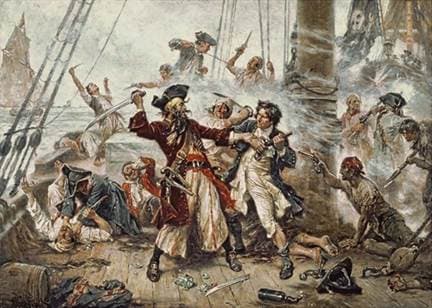
Capture of the Pirate, Blackbeard, 1718 depicting the battle between Blackbeard the Pirate and Lieutenant Maynard in Ocracoke Bay.